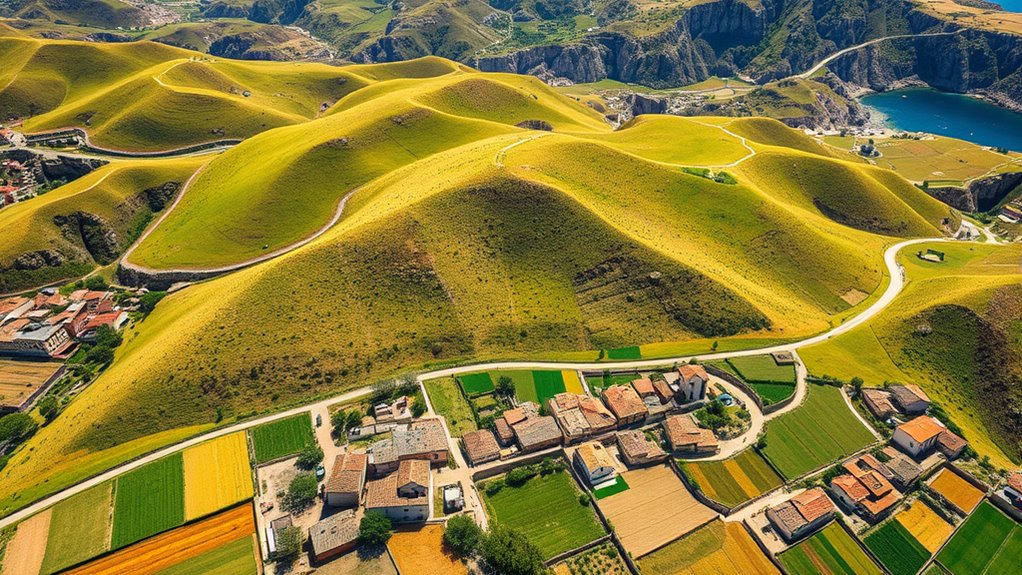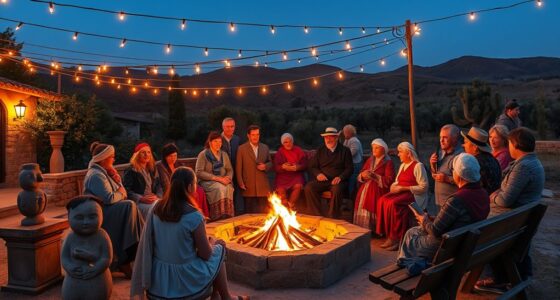Sardinian dialects vary quite a bit across regions. You’ll find four main groups: Campidanese in the south, Logudorese in the center and north, Sassarese in the northwest, and Gallurese in the northeast. Each has unique vocabulary, pronunciation, and grammar influenced by history, geography, and local identity. These differences can affect mutual understanding, and their rich diversity reflects Sardinia’s complex cultural mosaic. Exploring further reveals how history and society shape this fascinating linguistic landscape.
Key Takeaways
- Sardinian dialects include Campidanese, Logudorese, Sassarese, and Gallurese, each with distinct vocabulary, pronunciation, and grammatical features.
- Internal regional variations are significant, influenced by historical isolation, migrations, and local social factors.
- Dialect differences reflect diverse historical influences, including Latin, Catalan, Spanish, Arabic, and Italian contact.
- Mutual intelligibility varies, with some dialects understanding each other better than others due to phonetic and lexical divergence.
- Dialects face endangerment challenges, with regional differences complicating preservation and standardization efforts.
The Four Major Sardinian Dialects

The four major Sardinian dialects—Campidanese, Logudorese, Sassarese, and Gallurese—each reflect unique historical and linguistic influences. You’ll find Campidanese spoken mainly in southern Sardinia, especially in the Campidano plains. It’s known for a softer, more melodic tone and retains Latin phonetic traits, though it’s been shaped by past migrations. Logudorese, considered the “purest” Sardinian dialect, is common in central and northern regions. It preserves archaic features and Latin sounds, with a rougher inflection due to fewer foreign influences. Sassarese, mainly around Sassari, originates from Corsican roots and shows a mix of Sardinian and Corsican influences, making it distinct from the others. Gallurese, spoken in northeastern Sardinia, also derives from Corsican and is often viewed as a separate Romance language, reflecting its unique contact history. Linguistic classification of these dialects highlights their diverse origins and ongoing regional identities. Additionally, each dialect embodies regional identity, shaping local culture and communication styles.
Geographical Distribution and Regional Boundaries
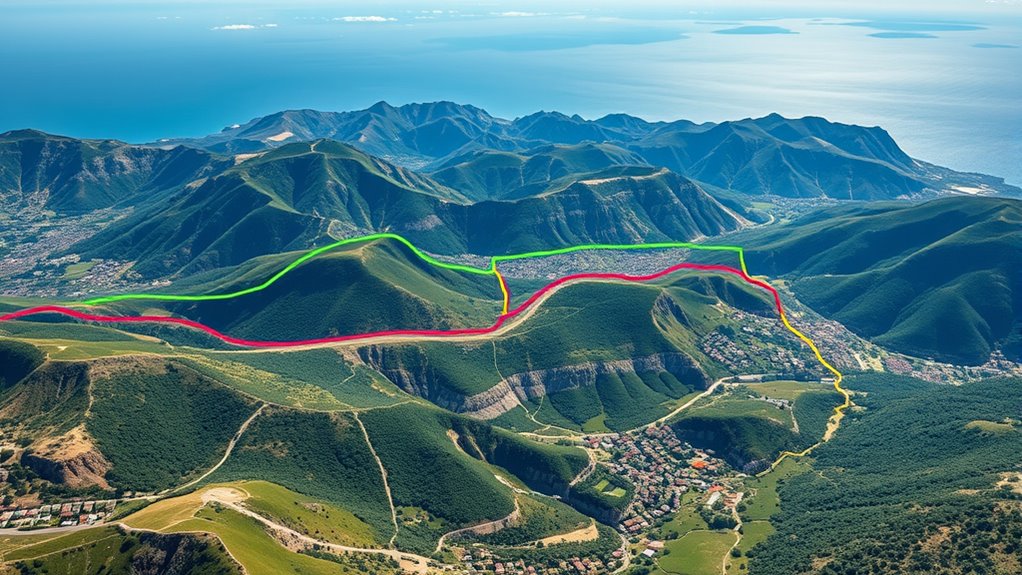
Sardinian dialects are mainly spoken across the island of Sardinia, with their distribution closely following the island’s geographical features. The central and northern regions chiefly use Logudorese, while the south is mainly Campidanese. Coastal areas like Sassari and Olbia feature Sassarese and Gallurese dialects, influenced by Corsican and Tuscan.
| Dialect | Location | Influences |
|---|---|---|
| Logudorese | Central-northern inland Sardinia | Latin, conservative traits |
| Campidanese | Southern Sardinia, including Cagliari | Spanish, Catalan influences |
| Sassarese | Northwestern Sardinia, Sassari area | Corsican, Tuscan influences |
Within these zones, local variations exist, reflecting town-specific history and geography. These boundaries highlight Sardinia’s linguistic diversity and regional identities.
Historical Influences Shaping Dialect Characteristics
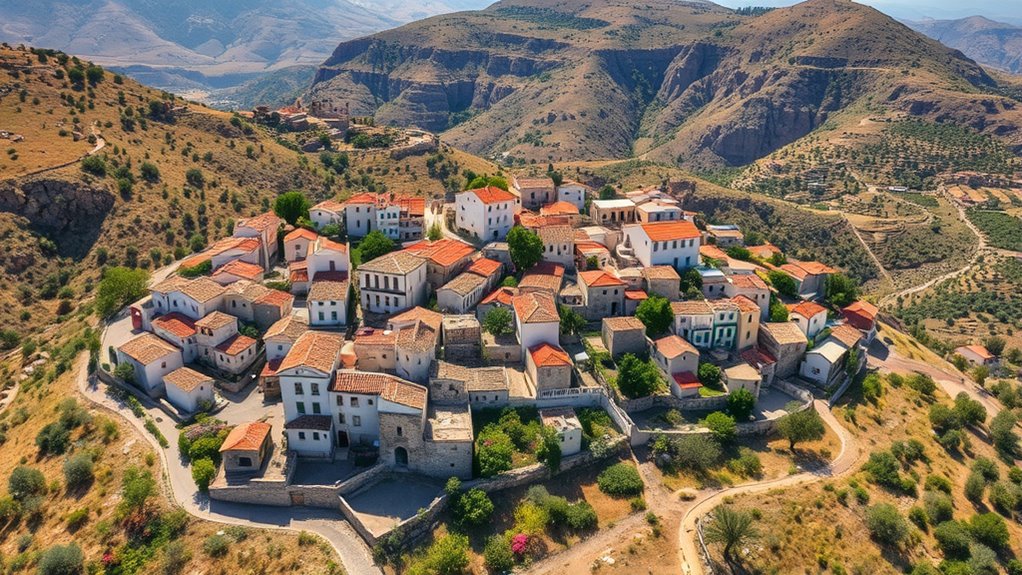
Multiple layers of historical contact have profoundly shaped the characteristics of Sardinian dialects. You can see this in the substratal elements from Paleo-Sardinian, possibly linked to Basque and Etruscan, and influences from North African Berber languages. The Roman conquest introduced Latin, but regional resistance and geographic isolation caused uneven Latinization, creating distinct dialects like Logudorese and Campidanese. Later, centuries of Aragonese, Spanish, and Italian rule added numerous loanwords and phonetic patterns, especially in southern Sardinia. Greek influences appeared through Byzantine rule, mainly in religious vocabulary, while Arabic contributions are subtle but present in place names. Corsican and Ligurian contacts, especially in Gallurese and Sassarese, further enriched dialect diversity, blending historical layers into Sardinia’s linguistic fabric. Additionally, ongoing research underscores how linguistic diversity in Sardinia reflects complex historical interactions over centuries.
Mutual Intelligibility and Internal Variations

You’ll find that understanding different Sardinian dialects isn’t always straightforward, as phonetic and vocabulary differences can create barriers. Variations within regions, like between Campidanese and Logudorese, often affect mutual comprehension. These internal differences highlight how regional and cultural factors shape dialectal understanding across the island. Mutual intelligibility between dialects can vary significantly, with some speakers understanding each other easily and others facing challenges. The linguistic diversity of Sardinian dialects is supported by ongoing research into their unique phonological and lexical features.
Dialectal Comprehension Challenges
Understanding the dialectal landscape of Sardinia reveals that, despite general mutual intelligibility, speakers often face comprehension hurdles due to internal variations. These differences, such as pronunciation shifts, unique vocabulary, and grammatical nuances, can create misunderstandings. For example:
- Phonological changes, like consonant shifts, make recognizing words difficult across dialects.
- Vocabulary differences, including regional idioms and local terms, hinder quick understanding.
- Sound substitutions and borrowings from Italian add layers of complexity, especially in formal contexts.
Additionally, asymmetrical comprehension occurs, where one dialect speaker may understand another better than vice versa. The absence of a standard language and regional pride further complicate mutual understanding, making communication across Sardinian dialects a nuanced challenge. Linguistic diversity within Sardinia reflects the island’s complex history of settlement and cultural influences, which continue to shape dialectal distinctions.
Variations Within Regions
Within Sardinia, dialectal variation occurs not only between major regional groups but also within individual regions, creating a complex tapestry of linguistic diversity. You’ll find differences even between nearby villages, often rooted in historical isolation or social factors. For example, Gennargentu’s remote villages preserve unique phonological features, while coastal towns like Cagliari show influence from external languages, leading to micro-variations. Within the same dialect subgroup, such as Logudorese, internal differences can be significant, shaped by local history and geography. These variations affect mutual intelligibility, with some villages understanding each other easily, while others develop distinct accents or lexical choices. Even within a single region, social changes, migration, and demographic shifts continuously influence how dialects evolve and diverge over time. Internal variation can also be seen in the use of specific vocabulary and expressions, which differ from one locality to another, reflecting local cultural identities. Moreover, the degree of mutual intelligibility among these dialects highlights the importance of regional history and social interactions in shaping linguistic boundaries.
Mutual Understanding Barriers
While dialectal variation within Sardinia creates a rich linguistic landscape, it also presents barriers to mutual understanding. The differences between dialects, especially between Campidanese and Logudorese-Nuorese, can hinder comprehension across regions. You’ll find that internal dialects share some mutual intelligibility, but this varies depending on regional features and exposure. Several factors influence these barriers:
- Structural and lexical differences make it hard for speakers from different areas to understand each other.
- Dialectal divergence, including phonological and syntactic variations, increases misunderstanding.
- Limited standardization and social exposure reduce the degree of mutual understanding, especially among younger generations.
- The Sardinian language is recognized as a distinct language, which further complicates efforts to unify dialects and promote mutual comprehension.
- Additionally, internal dialectal diversity is affected by historical, geographical, and social factors, further complicating communication.
These barriers highlight how internal diversity, combined with external influences like Italian, shape communication across Sardinia.
Phonetic and Lexical Distinctions

Sardinian dialects exhibit clear phonetic and lexical distinctions that set them apart from other Romance languages, shaped by their unique historical and geographic development. You’ll notice Sardinian’s five-vowel system, unlike Italian’s seven, and the preservation of Latin short vowels like Ĭ and Ŭ. Metaphony and intervocalic lenition influence pronunciation, especially in coastal regions. Consonants vary regionally; for example, /θ/ is prominent in Nuorese but shifting toward /t/. The fricative /f/ can be voiced or lost, and /s/ often appears as apico-alveolar /s/, especially in Nuorese. Lexically, Sardinian retains many Latin archaisms—words like *cerbu* for brain and *gelu* for ice—distinguishing it from Italian. Regional phonetic variation is also notable, with differences in phonemes and vocabulary, reflecting their distinct historical paths. Additionally, phonetic evolution has contributed to the unique sound patterns across regions, further emphasizing their linguistic diversity.
Influence of Neighboring Languages and Cultures

You can see how neighboring languages and cultures have shaped Sardinian dialects through words, pronunciation, and structure. Corsican, Tuscan, and Spanish influences are especially evident in northern and coastal areas, reflecting historical migration and rule. These interactions create unique linguistic blends that highlight Sardinia’s rich cultural exchanges. These influences have contributed to the distinct phonetic and lexical features observed in the dialects, showcasing the island’s diverse heritage. Additionally, linguistic contact with other Mediterranean languages has further enriched the dialects, adding layers of complexity and regional variation.
Neighboring Language Impact
Neighboring languages and historical interactions have profoundly shaped Sardinian dialects, creating a rich mosaic of linguistic influences across the island. You’ll notice how geography plays a role, with dialects reflecting regional contact. The dialects include influences from Corsican, Ligurian, Spanish, Catalan, and Italian, each contributing unique features. 1. The Corsican and Ligurian influence in Gallurese and Sassarese adds unique phonetic and vocabulary features, rooted in medieval migrations. 2. Spanish and Catalan left their mark on Campidanese, especially during periods of occupation, introducing loanwords and pronunciation quirks. 3. Italian’s growing presence, especially among younger speakers, influences vocabulary and usage, blending Sardinian with mainland Italian elements. These layers of contact and conquest have made Sardinian dialects a fascinating tapestry, where neighboring languages leave an unmistakable imprint, linguistic contact shaping regional speech patterns over centuries.
Cultural Exchange Effects
The cultural exchanges with neighboring regions have deeply influenced Sardinian dialects, embedding layers of historical and cultural significance into the language. You’ll notice how Latin’s legacy forms the core of Sardinian, while Spanish and Catalan loanwords reflect Iberian dominance, especially in Campidanese. Byzantine Greek governance introduced religious and administrative terms, blending with Latin roots, and Arabic influences subtly survive in place names and agriculture. Migration patterns shaped dialect distribution: Corsican refugees influenced Gallurese, while Ligurian and Italian settlers affected Sassarese. The influence of neighboring languages has played a crucial role in diversifying dialect features across the island. Despite pressures from Italian, Sardinian remains a crucial cultural marker, preserved through folklore, literature, and regional pride. The island’s history of conquest and trade has led to a rich tapestry of linguistic influences that continue to shape dialects today. These layers of cultural exchange highlight Sardinia’s role as a crossroads of Mediterranean and mainland influences, enriching its dialects with diverse linguistic flavors.
Preservation and Transmission of Dialects
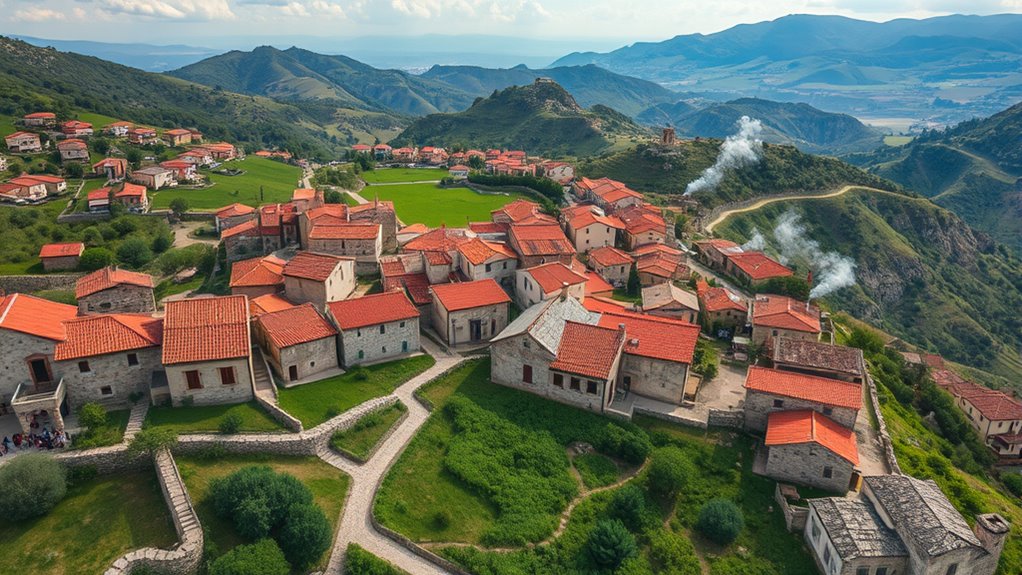
How can Sardinian be preserved when its transmission across generations faces significant challenges? Since UNESCO labels it as definitely endangered, the intergenerational transfer is fragile. Young Sardinians mainly speak Italian, and few children grow up fluent in Sardinian, limiting new native speakers. The language is often seen as a heritage relic, mainly spoken by grandparents. To combat this, you can focus on:
- Strengthening educational programs that promote Sardinian in schools and digital resources.
- Encouraging media exposure, like radio, TV, and social media, to normalize usage.
- Supporting cultural events that celebrate Sardinian language and identity, fostering pride and transmission.
Efforts to document and record local dialects are also crucial, as they preserve linguistic diversity and provide resources for future revitalization. These documentation initiatives help ensure the language’s linguistic diversity is maintained and accessible for subsequent generations.
These efforts aim to revive active use and preserve dialectal diversity for future generations.
Dialectal Impact on Local Identity and Culture

Dialectal diversity deeply shapes Sardinian identity, serving as a powerful expression of regional pride and cultural uniqueness. You notice that each dialect, like Campidanese in the south or Logudorese in the center and north, is more than just language—it’s a symbol of local heritage. In small towns and rural areas, people use these dialects daily, strengthening community bonds and preserving traditions. These dialects influence cultural events, music, and storytelling, making local customs more vibrant and authentic. When you hear a Sardinian dialect, you feel the deep connection to the land and its history. Even in urban areas, where Italian prevails, dialects remain a proud reminder of regional roots. They help define community identity and foster a strong sense of belonging across the island. Linguistic variation also reflects the island’s historical interactions with different cultures, further enriching its cultural mosaic.
Challenges Facing Sardinian Dialects Today

Sardinian dialects face significant threats as younger generations increasingly adopt Italian as their primary language, driven by limited transmission within families and communities. Since the 1960s, Sardinian has become mostly a memory of older family members, not a daily language for youths. This decline is worsened by the dominance of Italian in schools, media, and public life. UNESCO classifies Sardinian as “definitely endangered,” highlighting the risk of losing the language completely. Additionally, sociopolitical factors, such as Italy’s official language status, reduce Sardinian’s prestige. Internal disparities, like the stigmatized Campidanese dialect, also hinder unity. Without active efforts, globalization and digital gaps threaten to further diminish Sardinian’s liveliness and intergenerational use.
- Limited institutional support and lack of a standardized form
- Dominance of Italian media and education systems
- Digital resource gaps and technological challenges
The Role of Media and Education in Dialect Survival

Media and education play crucial roles in shaping the future of Sardinian dialects, especially as their use declines in everyday life. Social media, especially Facebook, keeps Sardinian alive, with 96.5% of users employing the language for reading and writing. This digital presence demonstrates the dialect’s vitality, despite challenges like the lack of standardization and limited written forms. In education, Sardinian remains mostly informal, used in small communities and with family, rather than in schools. Urban areas show lower proficiency and usage, with many claiming to speak Sardinian but lacking fluency. Promoting Sardinian through curricula and online platforms could boost competence and standardization, ensuring the dialect’s survival. Community engagement online also helps preserve regional varieties and cultural identity.
Frequently Asked Questions
How Do Sardinian Dialects Influence Local Customs and Traditions?
You see that Sardinian dialects shape local customs and traditions in many ways. They influence storytelling, festivals, and rituals, giving each region its unique flavor. Dialects determine the words used in folk songs, food, and ceremonies, fostering community pride. When you participate in local events, you notice dialect-specific phrases and costumes that reinforce regional identity, making traditions feel personal, authentic, and deeply rooted in your area’s linguistic heritage.
Are Sardinian Dialects Officially Recognized or Protected by Law?
Ever wonder if Sardinian dialects are protected by law? They are! Since 1999, Sardinian has been officially recognized as a minority language in Italy, allowing its use in schools and public administration. Regional laws also promote Sardinian and other local languages, giving them equal dignity with Italian. While challenges remain, this legal recognition helps preserve the rich linguistic diversity across Sardinia.
What Efforts Are Being Made to Revive or Promote Dialect Use Among Youth?
You can see efforts to revive Sardinian dialects through youth-focused initiatives. You might attend events organized by the Italian Youth Forum that showcase traditional expressions like Canto a tenore. You could also participate in online courses and local projects developed by Acadèmia de su Sardu, which aim to make learning dialects accessible. Community activities, media promotion, and regional plans also help encourage your active use and appreciation of Sardinian dialects.
How Do Dialects Vary Within Small Geographic Areas or Villages?
You notice that dialects can differ even within small villages, mainly because of historical influences, geographic isolation, and contact with outsiders. You’ll find subtle phonological differences, like vowel changes, and grammatical variations, such as object marking. These micro-variations shape how people speak locally, reflecting unique cultural histories and social interactions. As a result, even neighboring communities can have distinct dialect features that highlight their individual linguistic identities.
Can Non-Sardinians Easily Learn and Understand These Dialects?
Learning Sardinian dialects is like trying to catch butterflies—delightful but tricky. You’ll find it challenging because dialects differ widely across regions, with unique vocabulary, pronunciation, and influences. Without exposure or resources, understanding can be difficult. However, if you have a background in Romance languages or Latin, you might find some similarities that ease the process. Bilingual exposure from Italian education also helps you pick up key elements faster.
Conclusion
Think of Sardinian dialects as a vibrant tapestry woven through time and space. Each thread reflects a unique story, yet together they form a rich cultural mosaic. Preserving these dialects is like tending a delicate garden—you must nurture their roots to keep the colors alive. Embrace their diversity, for in doing so, you safeguard a living heritage that binds communities and keeps Sardinia’s soul shining brightly for generations to come.
